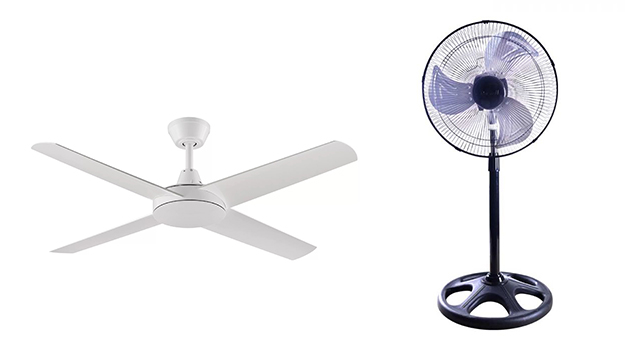- Smart Watch Payments and Digital Wallets in the Philippines - June 8, 2023
- Front-Load vs. Top-Load Washing Machines - May 25, 2023
- Pros And Cons Of Wireless Charging Power Banks - May 10, 2023
Last Updated on
Ceiling fans and stand fans have been around for years, but which one is best for you? Whether it’s the aesthetics, efficiency, cost-effectiveness, or convenience that matter to you most without having to rely on an air conditioner for cool air, this post will help you decide between these two fan favorites. Keep reading to learn more about ceiling fan vs stand fan.
Do you feel like your home needs some extra cooling down during the summer season? It can be a hard decision to make when trying to choose either a ceiling fan or a stand fan. Both provide a great way to cool off at home but there are several differences between them as well. In this blog post, we’ll discuss the pros and cons of each type of fan so that you can make an informed decision.
What is a ceiling fan?
A ceiling fan is a fan that hangs from the ceiling in a room and uses blades to generate air movement across the room. A ceiling fan is powered by electricity, but certain models are also available with remote control capabilities. They come in various shapes and sizes, so you have many options when it comes to choosing one for your home. One advantage of having a ceiling fan over any other type of fan is its ability to reduce energy costs during summer months by cooling down the room more effectively than stand fans.
What is a stand fan?
Stand fan or Pedestal fan, as their name implies, are designed to be placed on the floor or on another flat surface. They provide an effective way to cool down a room quickly and are powered by electricity. Pedestal fans come in various sizes, styles, and colors, so finding one that matches your decor is easy. Unlike ceiling fans, standing fans can be easily moved from room to room as needed.
Ceiling Fan vs Stand Fan:
Now that we’ve taken a look at both types of fans let’s compare them head-to-head.
Aesthetics:
Ceiling fans offer a more aesthetic appeal than standing fans since they hang from the ceiling and blend in with the rest of your decor. While stand fans can still add some style to your home, they may stick out more if they don’t match the rest of your room.
Efficiency:
Both standing fans and ceiling fans provide air circulation, but ceiling fans tend to be more efficient as they circulate air throughout the entire room rather than just in one specific area. Additionally, some ceiling fan models are capable of running at lower speeds for extended periods of time which can help reduce energy costs. On the other hand, pedestal fans typically only cool down an area directly around them.
Cost:
Ceiling fans tend to cost more upfront than a standing fan due to the additional installation costs associated with them. However, in terms of long-term costs, ceiling fans can result in significant savings when it comes to electricity bills since they use less energy than stand fans.
Maintenance:
Maintenance for ceiling fans tends to be more complex than pedestal fans as they require regular cleaning and lubrication of their parts in order to keep them running smoothly. Stand fans, on the other hand, can typically be cleaned with a damp cloth and require minimal maintenance.
Lifespan:
The lifespan of both types of a fan is usually quite long, but ceiling fans tend to last longer due to their sturdier construction and less frequent need for servicing or repairs.
Pros of Ceiling Fans:
1) They provide air circulation throughout the entire room rather than just one area
2) Ceiling fans use less energy which helps reduce electricity bills
3) They have a longer lifespan
4) They can add aesthetic appeal to your home
Cons of Ceiling Fans:
1) They require regular maintenance and servicing in order to stay running smoothly
2) Ceiling fans require installation
3) Some models are difficult to operate due to their remote control capabilities
Pros of Standing Fan:
1) They are more affordable upfront than ceiling fans
2) Easy to move from room to room as needed
3) Can provide cooling relief in one specific area quickly
4) Require minimal maintenance for cleaning and repairs.
Cons of Standing Fan:
1) Don’t circulate air throughout the entire room as a ceiling fan does
2) Tend to cost more in the long run due to their higher energy consumption
3) Can be an eyesore if they don’t match your decor.
In conclusion, both ceiling fans and pedestal fan have their pros and cons when it comes to cooling a room. It ultimately depends on your budget, aesthetic preferences, and needs as to which one is right for you. With that said, ceiling fans tend to be more efficient, longer-lasting, and provide better circulation throughout the entire room than stand fans. However, a standing fan is still a great option if you prefer something that is easier to move around or if you need a quick fix for cooling down an area without spending too much money upfront.

